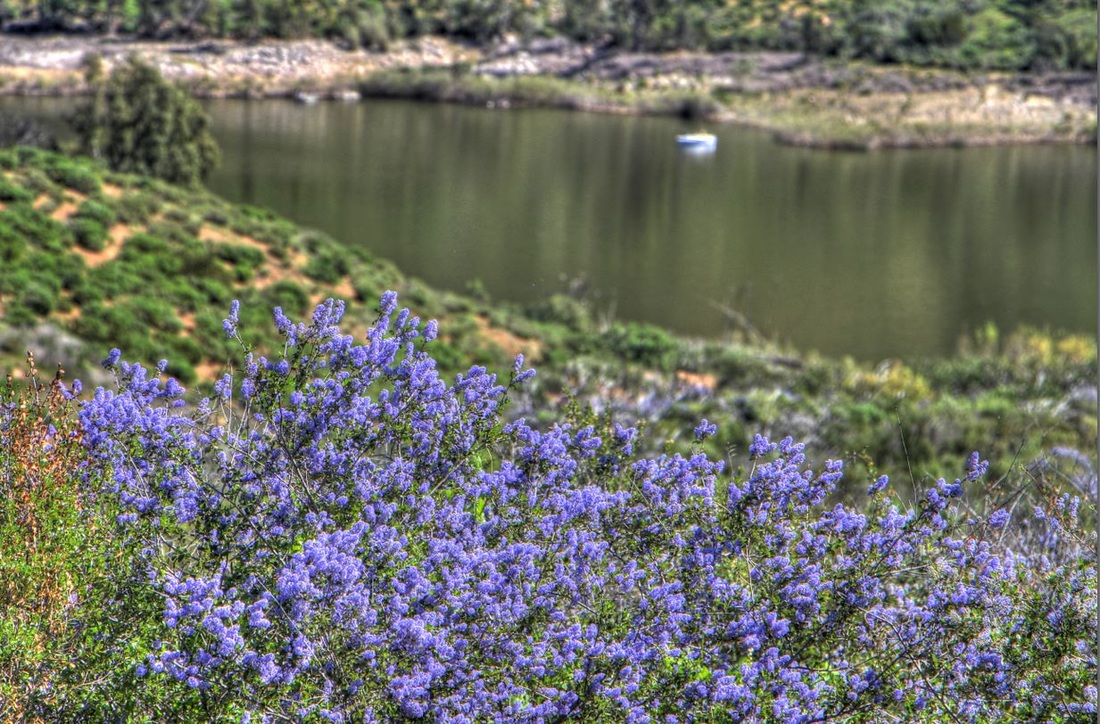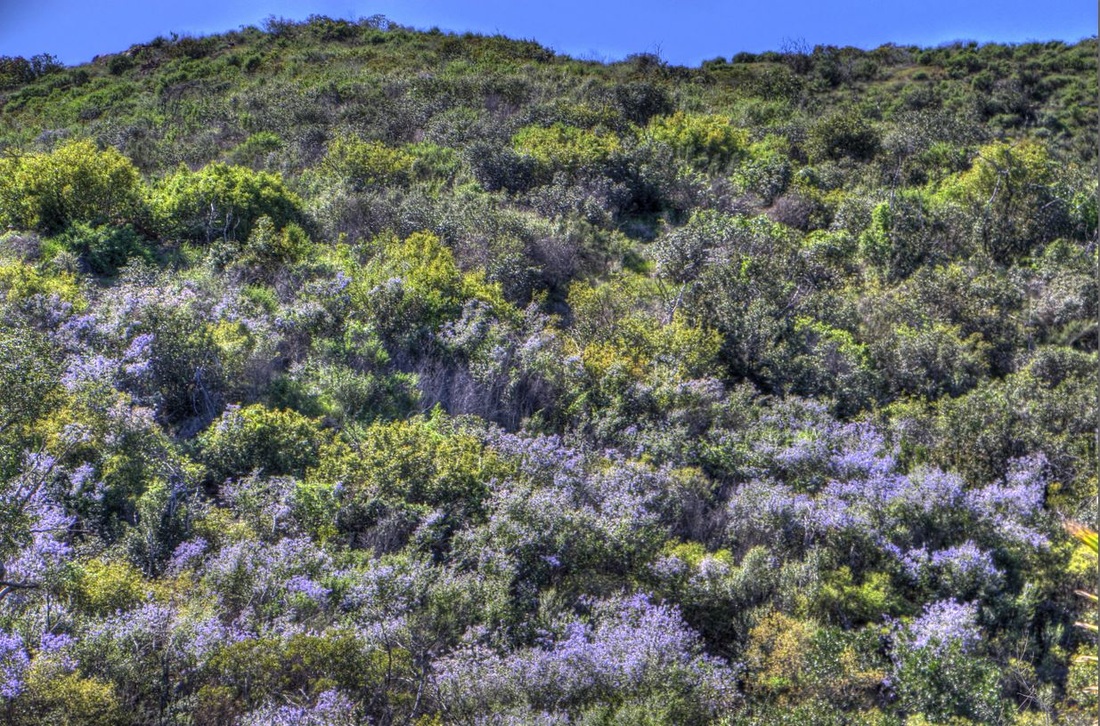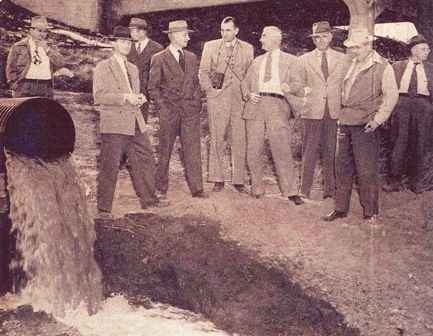Don't miss this stunning display of blue blooms around Lake Hodges of 'ceanothus' aka California Wild Lilac this month. Ceanothus flower colors range from a light frosted blue to cobalt blue. This may be a good sign for an increase in the deer population in and around Lake Hodges in Escondido as deer LOVE lilac. As it turns out Ceanothus is a great source of nutrition for deer, specifically mule deer here in north San Diego County. However, the leaves are not as nutritious from late spring to early fall as they are in early spring. Porcupines and quail have also been seen eating stems and seeds of these shrubs. The leaves are a good source of protein and the stems and leaves have been found to contain a high amount of calcium. Plants in this genus can be found on dry and sunny hillsides. Native Americans used the dried leaves of this plant as an herbal tea, and early pioneers used the plant as a substitute for black tea. Miwok Indians of California made baskets from ceanothus branches. C. integerrimus has been used by North American tribes to ease childbirth. All photos taken by Chaco using very basic and inexpensive camera gear as well as High Dynamic Range Exposure software.
|
Lake Hodges in Escondido, California.
Don't miss this stunning display of blue blooms around Lake Hodges of 'ceanothus' aka California Wild Lilac this month. Ceanothus flower colors range from a light frosted blue to cobalt blue. This may be a good sign for an increase in the deer population in and around Lake Hodges in Escondido as deer LOVE lilac. As it turns out Ceanothus is a great source of nutrition for deer, specifically mule deer here in north San Diego County. However, the leaves are not as nutritious from late spring to early fall as they are in early spring. Porcupines and quail have also been seen eating stems and seeds of these shrubs. The leaves are a good source of protein and the stems and leaves have been found to contain a high amount of calcium. Plants in this genus can be found on dry and sunny hillsides. Native Americans used the dried leaves of this plant as an herbal tea, and early pioneers used the plant as a substitute for black tea. Miwok Indians of California made baskets from ceanothus branches. C. integerrimus has been used by North American tribes to ease childbirth. All photos taken by Chaco using very basic and inexpensive camera gear as well as High Dynamic Range Exposure software. Lake Hodges in Escondido, California. The Del Dios Town Council Board is very excited to announce that Reservoir Keeper, Conway Bowman, will be this month's guest speaker at the meeting scheduled for Wednesday, Feb 10th at 7:00pm at the Old Fire House. He has worked for the city for many years and is a fixture here at Lake Hodges and will be coming to us with a wealth of knowledge and experience to make his presentation and answer your questions. Water level, fish count, affect of El Nino, impact of Colorado River water, inner-workings and goings-on of the administration of the Lake amongst other items will be on the agenda. Call board member Braden for more information about this meeting. 760.855.4232 The above photo was taken November of 1948 with the first Colorado River water spilling into Lake Hodges in Escondido, California. This occasion marked the completion of a water line from the San Vicente Reservoir, where the first Colorado River barrel empties into the San Diego County water system. This picture includes previous members of the Santa Fe Irrigation District, including (with camera) Former Board Director Reginald M. Clotfelter, Former General Manager D.M. Bakewell, Former Director William A. Smart, Former Director George Dose, and Former Director Harry Porter.
The Lake Hodges Dam Flume remained in service until 2003, as the only means of delivering water from Lake Hodges to SFID. In August 2003, a new 36-inch transmission pipeline was placed in service and use of the 75 year-old flume ceased. A new Rancho Cielo Raw Water Pump Station located on Del Dios Highway was also placed into service at that time providing an alternative means of moving water from Lake Hodges directly to the R.E. Badger Filtration Plant. The Santa Fe Irrigation District has 100% ownership of over 150 miles of pipelines, ranging from 8-inch to 36-inch diameter in size, as well as a six-million-gallon treated water reservoir in the City of Solana Beach called Larrick Reservoir. The reservoir was constructed in 1965 and named after H. G. Larrick, Senior, a Board Member of the Santa Fe Irrigation District from 1941 to 1957. In addition to owning and operating a water distribution system, SFID is joint owner (along with the San Dieguito Water District) of the R.E. Badger Water Filtration Plant, San Dieguito Reservoir, a hydroelectric power plant, raw water pumping stations and nearly 8 miles of transmission pipelines up to 54 inch diameter. During the construction of the Lake Hodges Dam, the San Dieguito Reservoir was also constructed in 1918. This terminal storage reservoir has the capacity to hold 550 acre feet of raw water. In 1967 the San Dieguito Reservoir Pump Station was constructed to pump water from the reservoir to the R.E. Badger Filtration Plant. |
Escondido real estate agents#1 No Bull Buyers agents and #1 Del Dios listing agents. Del Dios sales
August 2022
Escondido homes for sale in Lake Hodges
All
|



 RSS Feed
RSS Feed
